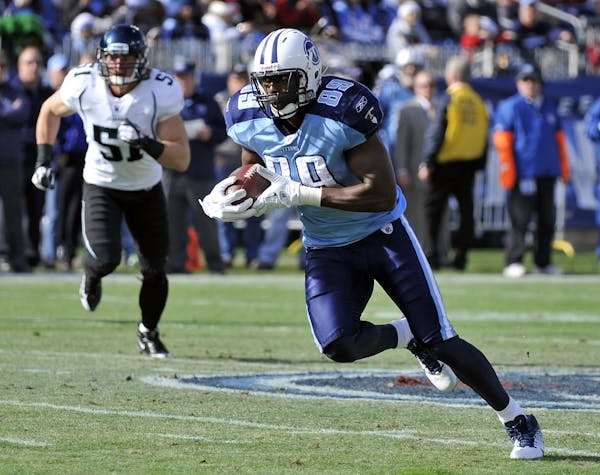If the thought of Mike Wallace playing for your favorite NFL team requires you reaching for a drool bucket, beware. The market for wide receivers has had its share of pitfalls going back to the infancy of the free-agency era.
In 1995, Andre Rison went from Atlanta to Cleveland as a sure thing, the final piece, a flamboyant potential future Hall of Famer. He flopped and was released after the season.
That same year, Alvin Harper went from Dallas to Tampa Bay as a can't-miss deep threat. He was 26 years old, a former SEC high jump champion and had led the league in average yards per catch (24.9) in 1994. He lasted 25 games over two years, posting a 14.5-yard average with just three touchdowns.
Remember Jerry Porter, who went from Oakland to Jacksonville in 2008? Collected $10 million, caught 11 passes and was done.
Remember Javon Walker, who went from Green Bay to Oakland in 2008? Collected $21 million, caught 15 passes. Done.
Remember Antonio Bryant? His first flop (San Francisco, 2006) was bad, but his second flop (Cincinnati, 2010) was career-ending.
The free-agency signing period begins anew Tuesday. By most if not all accounts, Wallace is the top player available at any position. The soon-to-be former Steeler is 26. He has 4.3 speed, 32 touchdowns in 63 games, a 17.2-yard average per catch and no history of injuries.
"He checks every box with few question marks," said former longtime NFL executive Bill Polian. "In terms of red flags that would cause you to turn away, he doesn't have many."
But is a guy with one Pro Bowl appearance and no All-Pro honors worth top dollar in today's increasingly wild wide receiver market? Even Steelers coach Mike Tomlin used to needle Wallace as a "one-trick pony" in an effort to get the deep threat to become a more complete receiver.
Meanwhile, the second-best receiver in free agency is Green Bay's Greg Jennings. He's definitely a complete receiver, but he also has a recent injury history and will turn 30 in September. What's he really worth?
"Worth," said Polian, "is in the eye of the beholder."
Worth also has taken on a new meaning since 2011, when former Vikings ballboy-turned-NFL superstar Larry Fitzgerald Jr. signed an eight-year, $120 million megadeal that averages out to $15 million a year.
It was the third time Fitzgerald set the market with a new deal since joining the league as the No. 3 overall pick in 2004. Detroit's Calvin Johnson has since signed an eight-year, $132 million deal worth a league-high average of $16.5 million.
Not only did Fitzgerald raise the bar for what a superstar receiver can expect to make, he also changed the market for all the very good receivers who fall in line behind him.
In other words, pencil Wallace in for a deal that pays him somewhere in the neighborhood of what Vincent Jackson got from Tampa Bay last year. And that's also an expensive neighborhood at an average of more than $11 million a year.
The Vikings are a very interested bystander in all of this. Two of their biggest priorities are acquiring another starting receiver while pacifying the elite starter they already have in Percy Harvin. Assuming he's not traded, Harvin might still hold out this summer if the Vikings force him to play for the $2.9 million he's due to make in the final year of his rookie deal.
The Vikings are one of many teams that take a conservative approach to free agency. They prefer to build through the draft while maintaining the financial strength to re-sign their own star players. So they won't be in the market to overpay for the top receiver.
They're more likely to let the market settle and then pursue second-tier youngsters such as 25-year-old Brandon Gibson and 25-year old Kevin Ogletree. It also helps that this year's draft class is talented and deep at the receiver position.
What will happen when free agency begins? Who knows? Even Polian, a six-time NFL Executive of the Year, said he routinely was surprised by the market when he was the top personnel guy in Buffalo, Carolina and Indianapolis.
"I often sat there and said, 'This player should command only X,' " Polian said. "And then the market would open up and that player would command X plus Y. And you'd say, 'Oops, that's not in our bailiwick?' We don't know what the market will bring. … That's what makes free agency interesting."
Olympic organizers unveil strategy for using artificial intelligence in sports
Olympic torch makes Acropolis overnight stop a week before handover to Paris organizers
Quarterback of the future? This Vikings mystery is about to end.

Wolves vs. Suns: Here are the match-ups . . . and a series prediction

